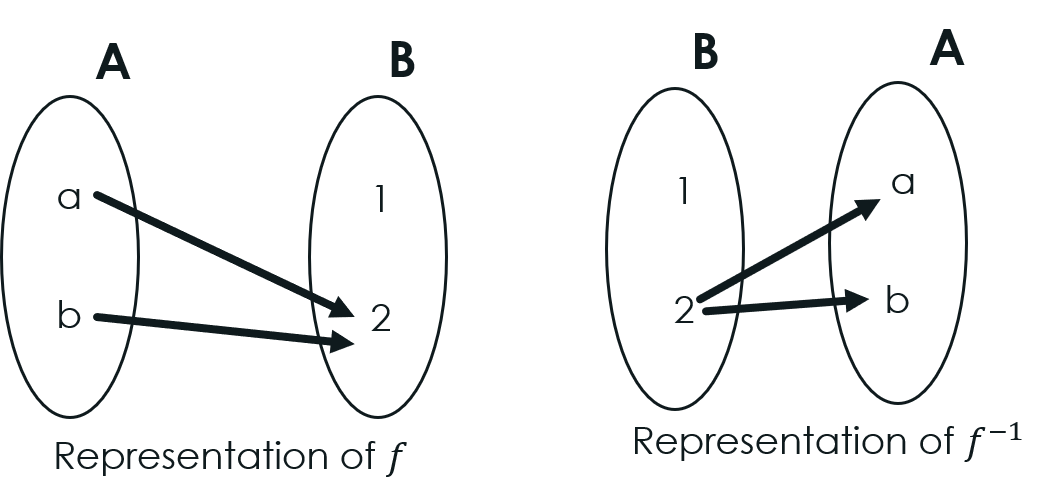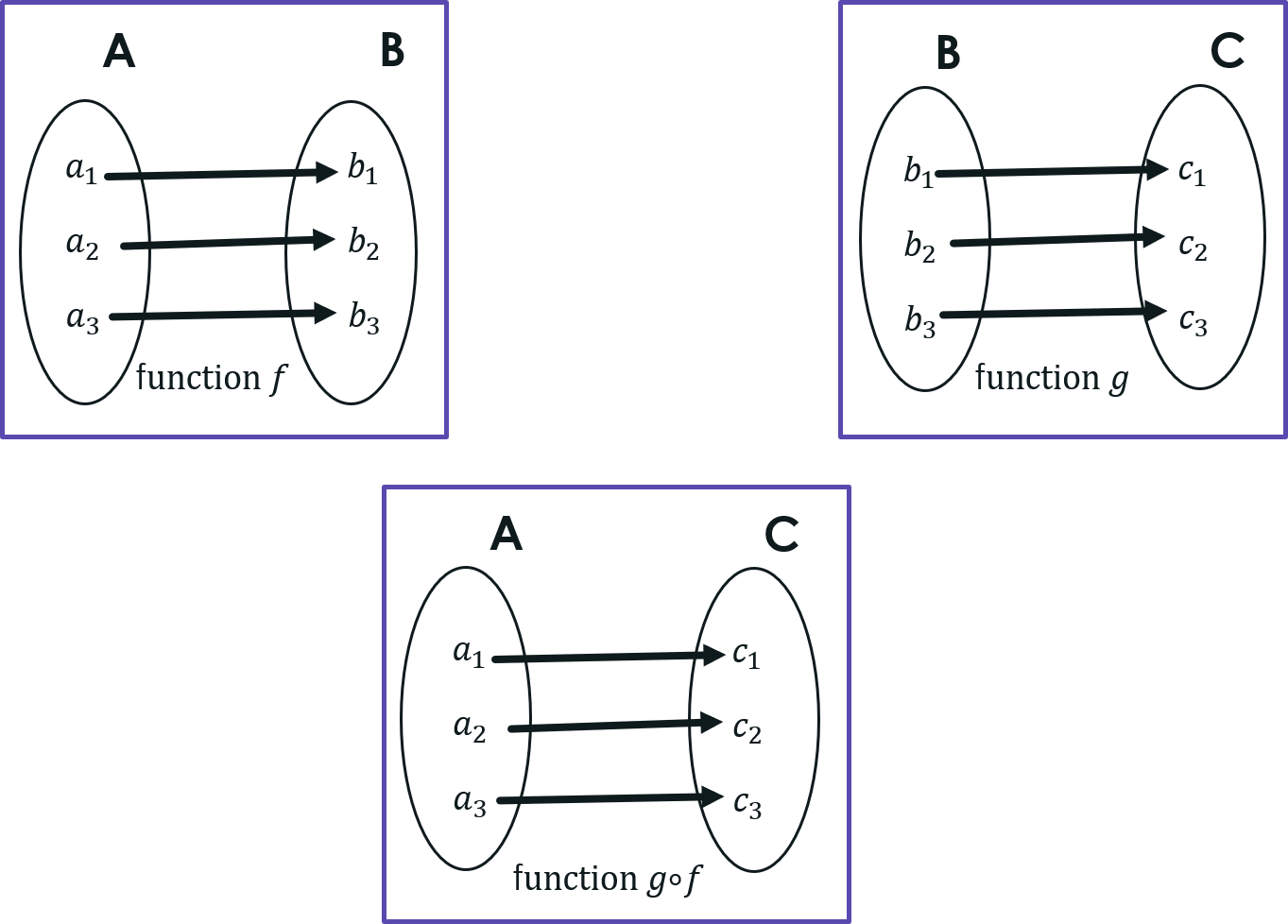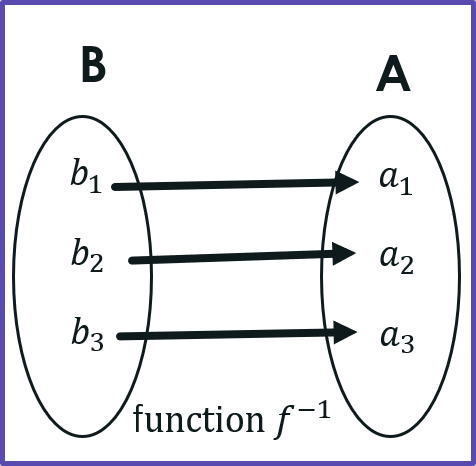Functions: Definitions and Types
Functions on sets:
A function F (or f) between A and B is a relation which satisfies the following conditions.
- The domain of F must be equal to A i.e., every element of A must occur at least in one pair
- Every element of the domain must be related to one and only one element of the range. i.e., if aRc and aRd then c=d. That is, a is related to only one element of B or equivalently, every element of A must occur in only one pair and not more than one pair.
Equivalently,
A function is a subset of AXB in which every element of A must occur in one and only one ordered pair. Some elements of B may not occur and one element of B may occur more than once in the ordered pairs.
If A = {a, b} and B = {1, 2 } then f = {(a, 2), (b, 2)} is a function on A since
1.All elements of A occurs in at least one pair.
2.All elements of A occurs in only one pair.
3.There is no need that all elements of B must occur.

- All elements of A occur in at least one pair.
- But a ∈ A occurs in more than one pair
Representation of Functions:
If A={a, b} , B={1, 2} take the function f = {(a, 2), (b, 2)} on A. Symbolically, function f is written as,
𝑓 :𝐴→𝐵
and read as f from A to B; Where A is the domain of f and range of f is a subset of B. The set representing f is replaced by the assignments
𝑓(a)=2 and 𝑓(b)=2
and read as f of a is equal to 2 and f of b is equal to 2. Elements of the domain A are said to be the arguments of f and the related element of the range is said to be its value or image. Functions may also be called mappings.
For example, in f(a)=2 , a is an argument of f and 2 is said to be the image (or value) of a in B.
Inverse of a function:
The function which has the range of 𝑓 as its domain and the domain of 𝑓 as its range is said to be the inverse function of 𝑓 and is written as 𝑓-1. In other words, if 𝑓 is a function from A into B then 𝑓-1 is a function from range(𝑓)⊆B onto A.
i.e., if 𝑓 :𝐴→𝐵 then 𝑓-1:range(𝑓)→A
For A={a, b} , B={1, 2} consider
𝑓= {(a,2), (b,2)}⊆AXB, i.e., 𝑓(a)=2 and 𝑓(b)=2
so the range of 𝑓 is the singleton set {2}⊆B because 1 is not related to any element of A. Clearly, 𝑓 is a function since both a and b elements of A exists in one and only one pair. Then 𝑓-1 is given by,
𝑓-1:{2}→A with 𝑓-1(2) = a and 𝑓-1(2) = b
a and b are said to be the inverse images of 2 and written as,
𝑓-1(2) = {a, b} = A

Here 𝑓-1 is a relation but not a function. The inverse of 𝑓 will also be a function iff 𝑓 is a 1-1 correspondence between A and B.
Image and Inverse image of sets:
𝑓(A) = {𝑓(x)| ∀ x∈A}
The inverse image of a set B is the set of all inverse images of elements of B. Symbolically,𝑓 -1(B) = {𝑓 -1(y)| ∀ y∈B}
If A={a1, a2,a3} and B={b1,b2,b3} thenfor 𝑓 :𝐴→𝐵 defined by 𝑓(ai) = bi then 𝑓(A)={𝑓 (a1), 𝑓 (a2), 𝑓 (a3)} = {b1,b2,b3} = B and 𝑓 -1(B)={𝑓 -1 (b1), 𝑓 -1 (b2), 𝑓 -1 (b3)} = {a1,a2,a3} = A
Here both 𝑓 and 𝑓 -1 are 1-1 correspondence between A and B and so |A| = |B|.Types of Functions:
A function 𝑓 from A to A
𝑓 :𝐴→𝐴
is said to be an identity function if 𝑓 maps the element to itself.
i.e., 𝑓(x) = x for every x∈A
Some times IA may also be used to denote identity function on A.
𝑓 :𝐴→𝐵
is said to be an into function if the range of 𝑓 is a subset of B. For example, if A={a, b} and B={1, 2} then the function 𝑓 defined by 𝑓 = {(a, 2), (b, 2)} on A is an into function sincerange of 𝑓 = {2} ⊆ B
This function can be read as 𝑓 from A into B. In into functions at least one element of B will not occur in any pair represent 𝑓.𝑓 :𝐴→𝐵
is said to be an onto function if the range of 𝑓 is the set B. For example, if A={a, b} and B={1, 2} then the function 𝑓 defined by 𝑓 = {(a, 2), (b, 1)} on A is an onto function sincerange of 𝑓 = {2, 1} = B
This function can be read as 𝑓 from A onto B. In onto functions every element of B occurs in at least one pair represent 𝑓.A function 𝑓 from A to B
𝑓 :𝐴→𝐵
is said to be an 1-1 (one to one) function if every element of the range of 𝑓 will be an image of only one element of A. For example, if A={a, b} and B={1, 2} then the function 𝑓 defined by 𝑓 = {(a, 2), (b, 1)} on A is an 1-1 function since
- 1∈B is an image of only one element and
- 2∈B is an image of only one element
A function 𝑓 from A to B
𝑓 :𝐴→𝐵
is said to be a bijection if it is both 1-1 and onto. Then 𝑓 is said to be a bijection from A onto B or an 1-1 correspondence between A and B. Then, |A| = |B|.
Composition of Functions:
If 𝑓 is a function from A to B and g is a function from B to C then the Composition of 𝑓 and g is a function from A to C which maps an element ‘a’ of A to an element of C which is nothing but the image of ‘𝑓(a)’ under g. The composition of 𝑓 and g is denoted by g ∘ 𝑓.
If A={a1,a2,a3}, B={b1,b2,b3} and C={c1,c2,c3} then
for 𝑓 :𝐴→𝐵 defined by 𝑓(ai) = bi and
for g :B→C defined by g(bi) = ci then
(g ∘ 𝑓)(ai) = g(𝑓(ai)) = g(bi) = ci

If g = 𝑓 -1 then (g ∘ 𝑓)(ai) = (𝑓 -1 ∘ 𝑓)(ai) = 𝑓 -1(𝑓(ai)) = 𝑓 -1(bi) = ai = IA(ai). Therefore for any function 𝑓, (𝑓 -1 ∘ 𝑓) = I, the identity function on the domain of 𝑓.
